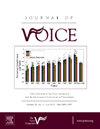针对良性声带褶皱病变的术前和术后嗓音治疗:国际电子德尔菲共识研究。
IF 2.5
4区 医学
Q1 AUDIOLOGY & SPEECH-LANGUAGE PATHOLOGY
引用次数: 0
摘要
导言:良性声带病变(BVFLs)的嗓音治疗方法多种多样,目前尚无临床指南。对嗓音治疗干预措施的描述不清导致治疗中出现不必要的差异。对现有证据的三角分析发现了一些潜在的最佳实践要素,但同时也发现了一些有待探讨的问题。本研究的目的是完善针对成人 BVFLs 患者术前和术后嗓音治疗干预的 "最佳实践",并就此达成全球共识:方法: 我们招募了国际样本的专业嗓音治疗师(n = 42)参与这项三轮电子改良德尔菲研究。研究人员向参与者提供了有关术前和术后嗓音治疗干预的陈述。这些陈述是根据以往的研究和 TIDieR 检查表(例如,为什么、什么时候、做什么、怎么做?超过 75% 的参与者同意或非常同意某一陈述即为达成共识。如果未达成共识,则根据参与者的评论生成新的陈述,并在下一轮中进行评分。结果:结果:42 位国际专家就 33 项声明达成了共识,这些声明涉及 BVFLs 患者术前和术后嗓音治疗干预最佳实践的组成部分。共识率从 81% 到 100% 不等。这些声明被明确映射到 TIDieR 核对表中,以确保干预的各个方面都得到考虑,并解决了 "为什么、做什么、怎么做、何时做以及个人定制 "等问题:这项研究大大加深了我们对最佳术前和术后嗓音治疗干预措施的理解。现在,重要的是在考虑有效性研究之前,对这些研究结果的可接受性和可行性进行测试。本文章由计算机程序翻译,如有差异,请以英文原文为准。
Pre- and Postoperative Voice Therapy for Benign Vocal Fold Lesions: An International Electronic Delphi Consensus Study
Introduction
Voice therapy management of benign vocal fold lesions (BVFLs) is variable and there are currently no clinical guidelines. Poor descriptions of voice therapy interventions lead to unwarranted variation in treatment. Triangulation of the current evidence identifies a number of potential best practice elements, but also a number of outstanding questions to be explored. The aim of this study was to refine and gain global consensus on “best practice” for a pre- and postoperative voice therapy intervention for adults with BVFLs.
Methods
An international sample of expert voice therapists (n = 42) were recruited to take part in this three-round electronic modified Delphi study. Participants were presented with statements concerning a pre- and postoperative voice therapy intervention. Statements were developed from previous research and based on the TIDieR checklist (eg, why, when, what, how?) Participants rated the extent to which they agreed or disagreed with a statement and gave comments to support their response. Consensus was defined as >75% of participants agreeing or strongly agreeing with a given statement. If consensus was not reached, participant comments were used to generate new statements and were rated in the next round. Stability of consensus between rounds was assessed.
Results
The 42 international experts achieved consensus on 33 statements relating to components of a best practice pre- and postoperative voice therapy intervention for patients with BVFLs. Consensus on statements ranged from 81% to 100%. These statements were explicitly mapped to the TIDieR checklist to ensure that all aspects of the intervention were considered and the questions of “why, what, how, when and individual tailoring” were addressed.
Conclusions
This study has significantly enhanced our understanding of what should be in a best practice pre- and postoperative voice therapy intervention. It is important to now test these findings for acceptability and feasibility, prior to considering effectiveness research.
求助全文
通过发布文献求助,成功后即可免费获取论文全文。
去求助
来源期刊

Journal of Voice
医学-耳鼻喉科学
CiteScore
4.00
自引率
13.60%
发文量
395
审稿时长
59 days
期刊介绍:
The Journal of Voice is widely regarded as the world''s premiere journal for voice medicine and research. This peer-reviewed publication is listed in Index Medicus and is indexed by the Institute for Scientific Information. The journal contains articles written by experts throughout the world on all topics in voice sciences, voice medicine and surgery, and speech-language pathologists'' management of voice-related problems. The journal includes clinical articles, clinical research, and laboratory research. Members of the Foundation receive the journal as a benefit of membership.
 求助内容:
求助内容: 应助结果提醒方式:
应助结果提醒方式:


